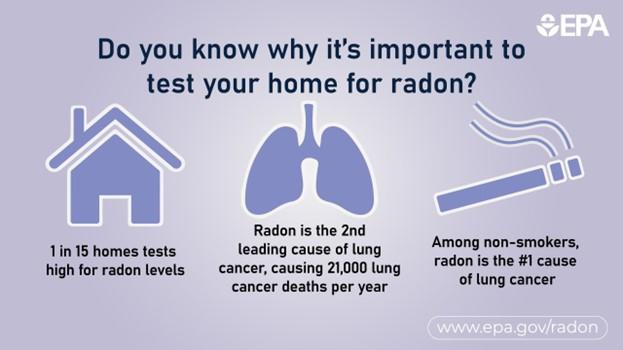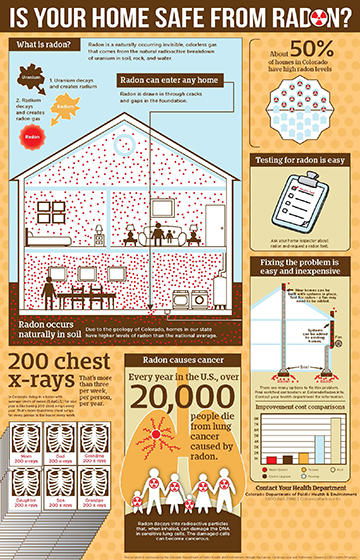Radon Health Risks
Testing Your Home for Radon
All citizens of Las Animas and Huerfano counties are urged to test their homes for radon, or you are welcome to stop by the health department office closest to you to pick up a radon test kit in person.
Questions about how to use your radon test kit?
| Las Animas County: (719) 846-2213 412 Benedicta Ave, Trinidad CO 81082 | Huerfano County: (719) 738-2650 119 E 5th Street, Walsenburg CO 81089 |
List of Licensed Radon Professionals
What is Radon?
Radon comes from the natural radioactive breakdown of uranium in soil, rock, and water. It is an invisible, odorless, tasteless, cancer-causing gas that enters buildings through the numerous cracks, holes, and pipes in the foundation. It can also enter a building from well water.
Radon can be found in any building, but homes are the most concerning since that’s where families spend the most time.
Click to view Colorado pre-mitigation indoor radon results by county.

Colorado Low-income Radon Mitigation Assistance Program (LIRMA)
To those who qualify, the state of Colorado offers financial assistance to reduce radon in your home. Learn more about CDPHE Low Income Radon Mitigation Assistance program.
Colorado’s radon mitigation assistance program has become more popular
Low Income Radon Mitigation Assistance Program Homeowner Application
Radon Can Cause Lung Cancer Among Non-Smokers
Radon breaks down into radioactive particles that can cause cancer when inhaled. These radioactive particles can damage the cells in our lungs and increase the risk of lung cancer. Radon is the leading cause of lung cancer among non-smokers, and second leading cause of lung cancer for smokers (tobacco use is the number one cause of lung cancer among smokers). It is estimated to cause about 21,000 lung cancer deaths per year and about $2 billion in medical expenses and lost productivity.
The Iowa Radon Lung Cancer Study tracked nearly 1,000 women who had lived in their homes more than 20 years. The results of the case-control study (after adjusting for age, smoking, and other factors) indicated that a 20-year exposure of radon levels at the EPA guideline of 4.0 pCi/L yielded an increased lung cancer risk of 50%.
2021-2025 Colorado Cancer Plan
The Colorado Cancer Plan has guided the prevention, treatment, and control of cancer statewide for more than 25 years. Decreasing environmental exposures that lead to cancer, including exposure to radon, is one of four goals of the 2021-2025 Colorado Cancer Plan.

Radon and Smoking Produce a Synergistic Effect
Smokers exposed to high concentrations of radon have even a greater risk of developing lung cancer than being exposed to either substance individually. The risk of lung cancer from radon gas is estimated to be approximately 10 -15 times greater for persons who smoke cigarettes in comparison with those who have never smoked. Get help to quit using tobacco.
The Face of Radon-Related Lung Cancer
The following video features Johanna Carpine of Wellington, Colorado. She was diagnosed with radon-related lung cancer in 2013. After a two-year battle, Johanna died on August 21, 2015.
Radon Resources
A Citizen’s Guide to Radon (English)
A Citizen’s Guide to Radon (Spanish)
Health Care Providers’ Guide to Radon
Consumer’s Guide to Radon Reduction
World Health Organization Radon Handbook
Radon and Real Estate in Colorado
Measuring and Mitigating Radon in Colorado
Presence of Radon Gas in Your Home
Radon Resistant New Construction Checklist
Information about Radon Venting
Find a Certified Radon Contractor in Colorado
